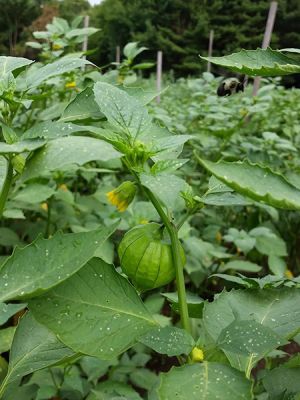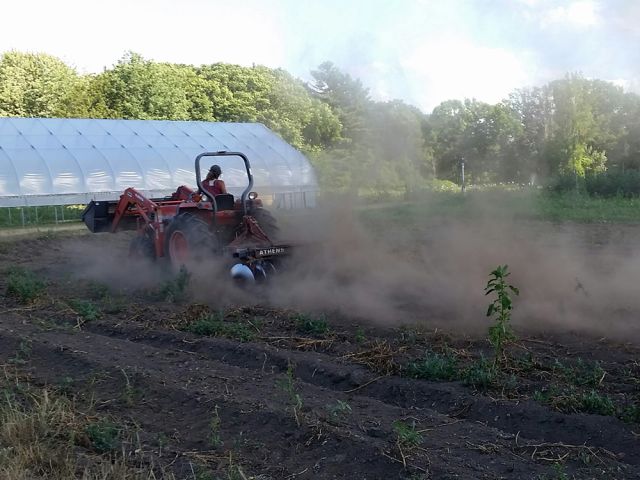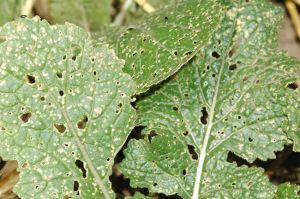Although last week brought more of the same - yup, hot and dry - by Friday we at least had the first cloud cover that we've seen in weeks. The rain predicted for Friday, Saturday and Sunday didn't amount to much, and we're still very much feeling the effects of the drought that 99% of Massachusetts is experiencing. It's not just that we're moving our irrigation systems constantly, which has accounted for many, many labor hours this year, but that it has been impossible to get a buildup of soil moisture. The depth of dryness is so extensive, the soil particles are so desiccated and the air has been so hot that the tension between getting water on as many crops as possible over the course of a week and having water on crops long enough to really soak them has been one we can't ease. Lack of water leads to stressed crops which in turn makes them more susceptible to pests and disease. We're seeing this effect heavily in our spring planted kale and collards, which are staples of the CSA distribution and our Outreach Market. It used to be that flea beetle pressure would be high in the spring but by the time we were putting fall brassicas in the ground in mid-July, pressure would be low enough to not affect them too much. There would be a perfect lull in the population and when the second generation appeared briefly in the hot days of August, the plants would be established enough to fend them off and be less appealing to the pest. This summer is the worst pressure I've seen of the beetle, and our newly planted cabbages, kale, collards, broccoli, cauliflower, and especially Napa have already needed a spraying of the few approved controls we're able to use in organic production. We seem to be in the midst of a population boom with the second generation coming on earlier than ever.
One of the other big challenges the drought has presented has been with our direct seeded crops. Most of what we grow is started in the greenhouse and transplanted out into the fields as seedlings. A few crops, namely carrots, dill, cilantro and beans, are seeded multiple times throughout the season directly in ground. Usually just a little soil moisture is enough to get these guys germinated and popping through the soil, either ahead of or neck and neck with the plentiful weed seeds in our fields. This year we're struggling with all in-field germination, which has been erratic, unreliable and sometimes just not there. The weeds, however, are as opportunistic as ever, and the irrigation that we're putting on our direct seeded beds has frustratingly been enough to encourage weed germination but not our crops. When this happens, it becomes extremely difficult to cultivate or even hand weed the beds. A flush of weeds grows rapidly, and if we've got our cilantro or carrots coming up a week later at best, and another week or so before the crops are established enough to actually weed around, then we end up in quite a pickle. At that point, the weeds are so well rooted that it becomes even more disruptive to pull them out and increases the likelihood of pulling out the small, tender, just barely there crop. On top of that, the soil is probably pretty dry, because we probably have the irrigation going on the newly planted lettuce that we're trying to keep alive in the 95 degree heat. Weeding small crops in these hot and dry conditions can actually disrupt the plants to create more harm than good. My hope here is that you can start to understand why the beans, dill and cilantro you may be picking in the next couple weeks are such a hairy jungle. Luckily, the cherry and plum tomatoes have strong fruit sets and we're starting to see some more consistent ripening with them. We're getting water on the tomatillos and husk cherries as much as we can and hoping to see them, along with the chiles, come on in the next few weeks.
 It's tough to keep energy and attitude from faltering in the kind of weather we've had this season.The past few weeks in particular have been so hot and trying that it's demanded a real commitment to community and camaraderie from everyone working in the fields. Thankfully, everyone was able to rise above the impossible drain of the heat waves and keep on keeping on. By Friday we had those precious clouds all day (though not filled with nearly as much rain as we would have liked) and I was feeling the cumulative fatigue of countless 90+ degree days and relentless sun. But with a spirit true to both farm crews this year, everyone rallied for a 3:30 power push, getting the last of our cauliflower planted in record time, all of us racing against our own exhaustion. With a final burst of energy, we surged through the end of July together.
It's tough to keep energy and attitude from faltering in the kind of weather we've had this season.The past few weeks in particular have been so hot and trying that it's demanded a real commitment to community and camaraderie from everyone working in the fields. Thankfully, everyone was able to rise above the impossible drain of the heat waves and keep on keeping on. By Friday we had those precious clouds all day (though not filled with nearly as much rain as we would have liked) and I was feeling the cumulative fatigue of countless 90+ degree days and relentless sun. But with a spirit true to both farm crews this year, everyone rallied for a 3:30 power push, getting the last of our cauliflower planted in record time, all of us racing against our own exhaustion. With a final burst of energy, we surged through the end of July together.Enjoy the harvest!
-Erinn, Farm Manager
for the farm staff




